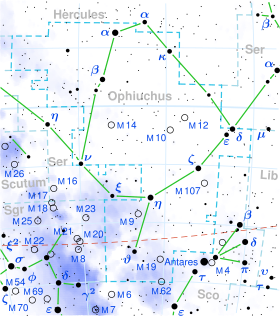| Observation data Epoch J2000 Equinox J2000 | |
|---|---|
| Constellation | Ophiuchus |
| Right ascension | 18h 01m 45.19884s[1] |
| Declination | 1° 18′ 18.2775″[1] |
| Apparent magnitude (V) | 4.42[2] + 7.48[3] |
| Characteristics | |
| Spectral type | A2Vn[4] |
| U−B color index | +0.02[5] |
| B−V color index | +0.04[5] |
| Astrometry | |
| Radial velocity (Rv) | +6.00[6] km/s |
| Proper motion (μ) | RA: +15.93[1] mas/yr Dec.: -13.29[1] mas/yr |
| Parallax (π) | 11.15 ± 0.60 mas[1] |
| Distance | 290 ± 20 ly (90 ± 5 pc) |
| Absolute magnitude (MV) | -0.34[2] |
| Orbit[7] | |
| Period (P) | 175.74±4.65 yr |
| Semi-major axis (a) | 1.090±0.027″ |
| Eccentricity (e) | 0.831±0.035 |
| Inclination (i) | 69.5±3.0° |
| Longitude of the node (Ω) | 160.2±1.6° |
| Periastron epoch (T) | 2019.87±1.48 |
| Argument of periastron (ω) (secondary) | 78.9±4.7° |
| Details | |
| 68 Oph A | |
| Mass | 3.07[8] M☉ |
| Radius | 4.5[9] R☉ |
| Luminosity | 160[8] L☉ |
| Surface gravity (log g) | 3.76[10] cgs |
| Temperature | 9,594[8] K |
| Metallicity [Fe/H] | -0.14[11] dex |
| Rotational velocity (v sin i) | 201[8] km/s |
| Other designations | |
| Database references | |
| SIMBAD | data |
68 Ophiuchi is a binary star system in the equatorial constellation of Ophiuchus. It is visible to the naked eye as a faint star with an apparent visual magnitude of 4.42.[2] The system is located around 89.69 parsecs (292.5 ly) distant from the Sun, based on parallax,[1] and is drifting further away with a radial velocity of +6 km/s.[6]
This is a spectroscopic binary with an orbital period of 177 years and an eccentricity of 0.83.[7] The brighter member, component A, is an A-type main-sequence star of spectral type A2Vn,[4] a star that is currently fusing its core hydrogen. The 'n' suffix indicates "nebulous" lines due to rapid rotation. The star is suspected of varying between magnitudes 4.42 and 4.48.[12] It displays an infrared excess that matches a circumstellar disk of dust orbiting 32.5 AU from the star with a mean temperature of 160 K.[13] The secondary companion, component B, is of magnitude 7.48.[3][14]
- ^ a b c d e f Van Leeuwen, F. (2007). "Validation of the new Hipparcos reduction". Astronomy and Astrophysics. 474 (2): 653–664. arXiv:0708.1752. Bibcode:2007A&A...474..653V. doi:10.1051/0004-6361:20078357. S2CID 18759600. Vizier catalog entry
- ^ a b c Anderson, E.; Francis, Ch. (2012). "XHIP: An extended hipparcos compilation". Astronomy Letters. 38 (5): 331. arXiv:1108.4971. Bibcode:2012AstL...38..331A. doi:10.1134/S1063773712050015. S2CID 119257644. Vizier catalog entry
- ^ a b Malkov, O. Yu.; Tamazian, V. S.; Docobo, J. A.; Chulkov, D. A. (2012). "Dynamical masses of a selected sample of orbital binaries". Astronomy & Astrophysics. 546: A69. Bibcode:2012A&A...546A..69M. doi:10.1051/0004-6361/201219774. Vizier catalog entry
- ^ a b Hoffleit, D.; Warren, W. H. (1995). "VizieR Online Data Catalog: Bright Star Catalogue, 5th Revised Ed. (Hoffleit+, 1991)". VizieR On-line Data Catalog: V/50. Originally Published in: 1964BS....C......0H. 5050. Bibcode:1995yCat.5050....0H.
- ^ a b Mallama, A. (2014). "Sloan Magnitudes for the Brightest Stars". The Journal of the American Association of Variable Star Observers. 42 (2): 443. Bibcode:2014JAVSO..42..443M.Vizier catalog entry
- ^ a b Gontcharov, G. A. (2006). "Pulkovo Compilation of Radial Velocities for 35 495 Hipparcos stars in a common system". Astronomy Letters. 32 (11): 759–771. arXiv:1606.08053. Bibcode:2006AstL...32..759G. doi:10.1134/S1063773706110065. S2CID 119231169.
- ^ a b Cite error: The named reference
Hartkopf2009was invoked but never defined (see the help page). - ^ a b c d Zorec, J.; Royer, F. (2012). "Rotational velocities of A-type stars". Astronomy & Astrophysics. 537: A120. arXiv:1201.2052. Bibcode:2012A&A...537A.120Z. doi:10.1051/0004-6361/201117691. S2CID 55586789. Vizier catalog entry
- ^ Allende Prieto, C.; Lambert, D. L. (1999). "Fundamental parameters of nearby stars from the comparison with evolutionary calculations: Masses, radii and effective temperatures". Astronomy and Astrophysics. 352: 555–562. arXiv:astro-ph/9911002. Bibcode:1999A&A...352..555A. Vizier catalog entry
- ^ David, Trevor J.; Hillenbrand, Lynne A. (2015). "The Ages of Early-Type Stars: Strömgren Photometric Methods Calibrated, Validated, Tested, and Applied to Hosts and Prospective Hosts of Directly Imaged Exoplanets". The Astrophysical Journal. 804 (2): 146. arXiv:1501.03154. Bibcode:2015ApJ...804..146D. doi:10.1088/0004-637X/804/2/146. S2CID 33401607. Vizier catalog entry
- ^ Wu, Yue; Singh, H. P.; Prugniel, P.; Gupta, R.; Koleva, M. (2010). "Coudé-feed stellar spectral library – atmospheric parameters". Astronomy & Astrophysics. 525: A71. arXiv:1009.1491. Bibcode:2011A&A...525A..71W. doi:10.1051/0004-6361/201015014. S2CID 53480665.
- ^ VSX (17 December 2005). "NSV 10009". AAVSO Website. American Association of Variable Star Observers. Retrieved 28 July 2014.
- ^ Cite error: The named reference
Cotten2016was invoked but never defined (see the help page). - ^ Cvetkovic, Z.; Ninkovic, S. (2010). "On the Component Masses of Visual Binaries". Serbian Astronomical Journal. 180 (180): 71. Bibcode:2010SerAJ.180...71C. doi:10.2298/SAJ1080071C.
